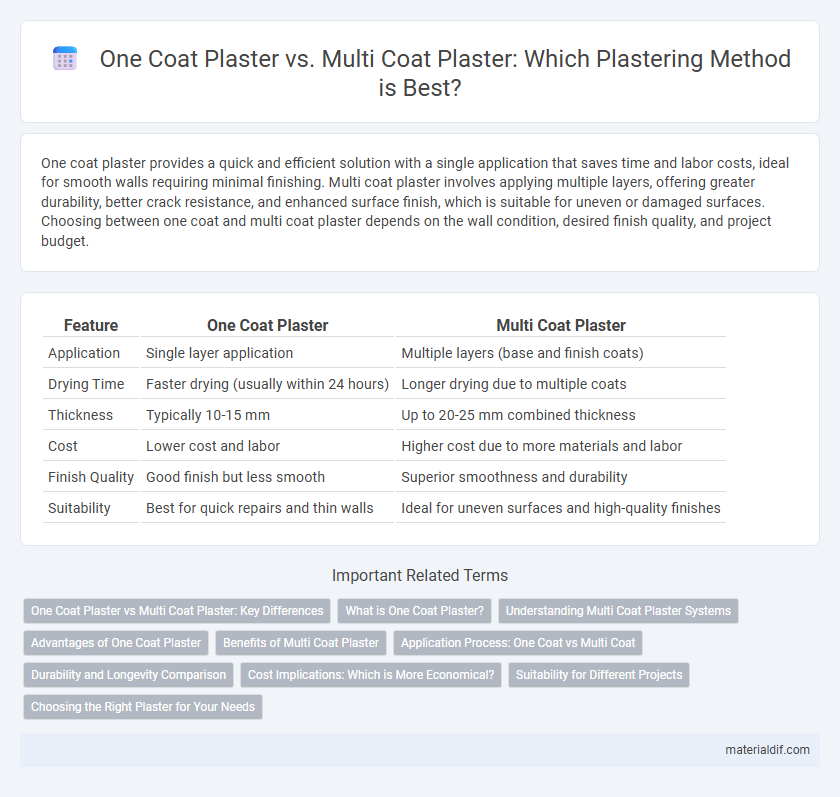One coat plaster provides a quick and efficient solution with a single application that saves time and labor costs, ideal for smooth walls requiring minimal finishing. Multi coat plaster involves applying multiple layers, offering greater durability, better crack resistance, and enhanced surface finish, which is suitable for uneven or damaged surfaces. Choosing between one coat and multi coat plaster depends on the wall condition, desired finish quality, and project budget.
Table of Comparison
| Feature | One Coat Plaster | Multi Coat Plaster |
|---|---|---|
| Application | Single layer application | Multiple layers (base and finish coats) |
| Drying Time | Faster drying (usually within 24 hours) | Longer drying due to multiple coats |
| Thickness | Typically 10-15 mm | Up to 20-25 mm combined thickness |
| Cost | Lower cost and labor | Higher cost due to more materials and labor |
| Finish Quality | Good finish but less smooth | Superior smoothness and durability |
| Suitability | Best for quick repairs and thin walls | Ideal for uneven surfaces and high-quality finishes |
One Coat Plaster vs Multi Coat Plaster: Key Differences
One coat plaster offers a faster application process and reduced labor costs compared to multi coat plaster, making it ideal for projects requiring efficiency. Multi coat plaster provides superior durability, a smoother finish, and better crack resistance due to its layered application, which enhances wall strength and longevity. Choosing between one coat and multi coat plaster depends on project requirements, budget constraints, and desired finish quality.
What is One Coat Plaster?
One Coat Plaster is a pre-blended, ready-to-use plaster designed for quick application with minimal layers, typically applied in a single coat to create a smooth finish. It is composed of gypsum or cement-based materials, providing efficient coverage and reducing labor time compared to traditional multi coat plaster systems. Ideal for drywall or brick surfaces, One Coat Plaster enhances project speed while maintaining durability and surface quality.
Understanding Multi Coat Plaster Systems
Multi coat plaster systems consist of several layers, typically including a base coat, intermediate coats, and a finish coat, creating a durable and smooth surface ideal for both interior and exterior walls. This layered approach enhances crack resistance, moisture control, and overall wall strength compared to one coat plaster, which applies a single layer and is less suitable for uneven or rough surfaces. Using materials like cement or lime-based plaster for multi coat systems allows for better adhesion and longer-lasting finishes, particularly in high-traffic or exposure-prone areas.
Advantages of One Coat Plaster
One coat plaster offers significant time and labor savings by eliminating the need for multiple application layers, making it ideal for fast-track projects. Its improved bonding properties and enhanced durability reduce the likelihood of cracking and shrinkage compared to multi coat systems. This efficiency results in lower overall material costs and quicker project completion without compromising on surface smoothness or strength.
Benefits of Multi Coat Plaster
Multi coat plaster offers enhanced durability and superior crack resistance compared to one coat plaster, ensuring long-lasting wall protection and finish. It provides better surface leveling and moisture control through multiple layers, resulting in improved adhesion and overall wall strength. This method also allows for greater flexibility in application thickness, adapting to uneven surfaces and delivering a smoother, professional appearance.
Application Process: One Coat vs Multi Coat
One coat plaster streamlines the application process by combining the base and finishing layers, reducing labor and drying time compared to multi coat plaster. Multi coat plaster involves separate layers--scratch, brown, and finish coats--each requiring precise drying and leveling to ensure durability and smoothness. Choosing between one coat and multi coat methods impacts project timelines, surface texture, and long-term performance depending on wall conditions and finish requirements.
Durability and Longevity Comparison
One coat plaster offers faster application but generally provides less durability and longevity compared to multi coat plaster, which involves a base and finish coat that enhances strength and resistance to cracking. Multi coat plaster systems create a thicker, more robust surface ideal for high-traffic areas or environments prone to moisture and impact. The increased durability of multi coat plaster reduces maintenance needs and extends the lifespan of walls significantly beyond one coat plaster installations.
Cost Implications: Which is More Economical?
One coat plaster typically incurs lower labor costs due to faster application, making it more economical for small or less complex projects. Multi coat plaster, while involving higher upfront labor and material expenses, offers enhanced durability and finish quality that may reduce long-term maintenance costs. Evaluating project size and desired finish longevity is crucial to determine the most cost-effective plastering method.
Suitability for Different Projects
One Coat Plaster is ideal for quick renovations and smooth finishes on interior walls where time and labor costs need to be minimized. Multi Coat Plaster provides superior durability and better surface leveling, making it suitable for new constructions and exterior surfaces exposed to harsh weather. Choosing between the two depends on project scale, environmental conditions, and desired finish quality.
Choosing the Right Plaster for Your Needs
One coat plaster offers a quicker application and is ideal for smooth, internal wall finishes, saving time and labor costs for straightforward projects. Multi coat plaster provides enhanced durability and better surface leveling, making it suitable for uneven walls or areas requiring reinforcement. Selecting the right plaster depends on the wall condition, project timeline, and desired finish quality to ensure optimal performance and longevity.
One Coat Plaster vs Multi Coat Plaster Infographic

 materialdif.com
materialdif.com